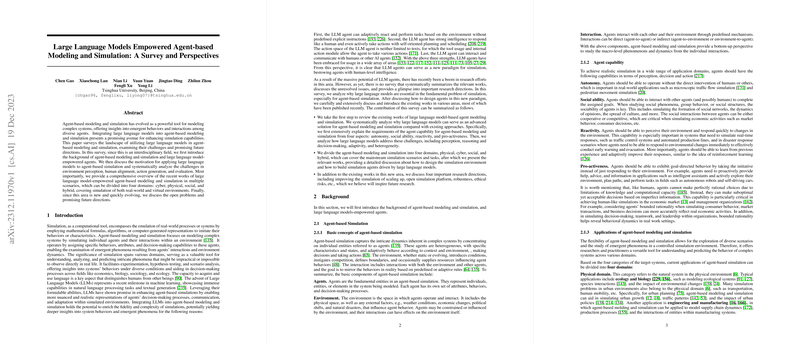LLMs Empowered Agent-based Modeling and Simulation: A Survey and Perspectives
Introduction
In the landscape of agent-based modeling and simulation (ABMS), the integration of LLMs presents an innovative approach, enhancing the simulation of complex systems with human-like decision-making processes. This paper surveys the use of LLMs in ABMS across cyber, physical, social, and hybrid domains, elucidating the motivation, challenges, recent advancements, and future directions in this interdisciplinary field.
Background on Agent-based Simulation and LLMs
Agent-based Simulation Concepts
ABMS harnesses the capabilities of agents, simulating their interactions within a defined environment to paper emergent behaviors. Key components of such simulations include:
- Agents: Individual entities with unique characteristics and decision-making processes.
- Environment: The context within which agents operate, influencing and being influenced by agent actions.
- Interaction: The dynamics between agents and between agents and the environment.
The Advent of LLM Empowered Agents
LLMs, with their profound natural language processing abilities, bring about a paradigm shift in ABMS. Their integration into simulations paves the way for simulations that closely mimic human behavior, enhancing the realism and depth of analyses. LLMs contribute significantly in areas of perception, reasoning, adaptive learning, and heterogeneity in agent interactions.
Challenges and Approaches in LLM-based ABMS
Environment Design and Interface
A pivotal step in LLM-based ABMS is environment construction, which can be virtual or real-world. The mechanisms for how agents perceive and interact with these environments predominantly revolve around textual interfaces, leveraging LLMs' natural language prowess. Such designs facilitate intricate simulations encompassing varying domains.
Addressing Human Alignment and Personalization
Aligning LLM agents with human knowledge and ethical values is crucial for realistic simulations. Techniques such as prompt engineering and tuning are employed to cater to domain-specific knowledge and individualized agent characteristics, enhancing the fidelity of the simulations.
Simulating Agent Actions
The paper discusses in depth how planning, memory, and reflection mechanisms are essential for LLM agents to exhibit complex behaviors. These attributes allow agents to strategize actions, recall past experiences, and adapt behaviors based on outcomes, closely aligning with human cognitive processes.
Evaluation Metrics
Evaluating the effectiveness of LLM-based simulations involves assessing the realism and coherence of agent behaviors, as well as adherence to ethical guidelines. Metrics include realness validation, explanatory capabilities of simulated behaviors, and ethical considerations such as bias detection and mitigation.
Recent Work and Domain-specific Advances
The survey presents an exhaustive list of advancements across cyber, physical, social, and hybrid domains. These include simulations for economic systems, social interactions, urban dynamics, and more complex systems that entail intricate interplay between different elements of society and environment.
Open Problems and Future Directions
The paper identifies key areas for future research:
- Scaling Efficiency: As the scale of simulations expands, computational efficiency becomes paramount. Innovative solutions for model compression and operation optimization are essential.
- Benchmarking: Establishing comprehensive benchmarks for evaluating LLM-based ABS across various metrics and domains.
- Open Platforms: The creation of open platforms would democratize access to LLM-based ABS, fostering wider innovation in the field.
- Robustness and Ethical Considerations: Addressing challenges related to adversarial attacks, out-of-distribution generalization, and mitigating ethical risks inherent in simulating human-like behaviors.
Conclusion
The integration of LLMs into ABMS marks a significant advancement in simulating complex systems with increased realism and depth. This paper highlights the transformative potential of LLM-empowered agents in ABMS, delineating current achievements and charting a course for future research in tackling the outlined challenges. As the field evolves, it promises to offer profound insights into the dynamics of complex systems, from social networks to economic systems, with implications that span across theoretical understanding to practical applications in policy-making and beyond.
